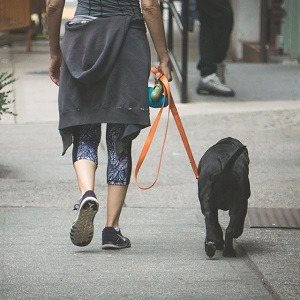Wondering how to walk your blind dog? After Stevie healed from her eye surgery, we were eager to get Stevie back out on a walk. She loved them so much before her surgery and thought nothing would change afterwards, but we were in for a big surprise. The first time we took her out after she lost her sight, she was petrified and froze. We tried to coax her with treats and calm her with our voice, but nothing worked. We went back inside and thought our dog walking days were over. But a few weeks later, we decided to try again, this time late at night. We reflected on our first time walking post-op and realized we probably made a mistake going out on a weekend in the middle of the day, we live in a city and the streets were packed with so many sounds and smells. No wonder Stevie was overwhelmed.
The late-night walk proved to be much better, still she was a little scared at the beginning, but she slowly got the hang of it. For the next couple of months, we only took Stevie out on walks early in the morning or late at night, when the streets were quieter. Slowly we moved our walks to busier and busier times to get her comfortable going on a walk at anytime of the day.
From the beginning we taught Stevie important words to help guide her along the way, for example “up” and “down” when we approached stairs. “Left” and “right” when we need to turn. We had the intention of using the word “danger” as her caution word for when she was about to hit something, but that turned into “hey, hey, hey!” Whatever works, right?
Walks are also an important time to be talking to your dog. Tell them they are doing a good job, let them know you are right there and that they are safe. Some people have found it useful attaching bells to their shoes to have a constant noise for their dog to listen for. A clicker can also be helpful in this situation. Re-teaching your blind dog how to go on walks will require patience, but your dog’s paws were made for walking…and that’s just what they’ll do!
